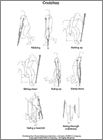
Crutches: How to Use
What are crutches?
Crutches are supports that help you walk when you have an injured leg or foot.
How do I use crutches?
Walking: Bring the crutches forward evenly, keeping your injured leg off the ground. Lean forward, putting your weight on your hands against the grips of the crutches. Don't rest your armpits on the crutches because the pressure can cause damage to a nerve that passes through the armpit. Swing your good leg forward, placing your foot just in front of the crutches. Repeat. (Note: In some cases your health care provider may allow you to put some weight on your injured leg while you are using crutches.)
Getting up from a chair or bed: Hold both crutches together by the grips in the hand on the side of the injured leg. Push up from the chair or bed with the other hand while you push up on the crutches. Use your good leg to bring you to a standing position. Get your balance and bring your crutches into position on either side of you before you start to walk.
Sitting down: Hold your crutches together by the grips in the hand on the injured side. Hold onto the chair or bed with the other hand and lower yourself slowly. Unless you are allowed to put some weight on your injured leg, keep your injured leg off the ground and keep your weight on the good leg.
Stairs: Going up, get close to the stairs. Step up with the good leg, then bring the crutches and the injured leg up to the step that the good leg is on. Repeat. Going down, first bring the crutches and the injured leg down to the lower step. Then step down with the good leg. Repeat. If there is a handrail, put both crutches under the opposite arm and use the rail for support. Remember: "Up with the good, down with the bad."
Going through doorways: Be sure to give yourself enough room to allow your feet and crutches to clear the door. After opening the door, block it from swinging closed with a crutch tip. Walk through the doorway.
How can I take care of myself while I'm using crutches?
- Be careful not to slip on water or ice.
- Sometimes crutches rub against the skin between your arm and chest. You may want to use body lotion or talcum powder to prevent skin chafing.
- If your hands get sore or tired, you may want to put extra padding on the crutch grips.
- Be sure not to lean on the crutches and put pressure on your armpits. If there is pressure on your armpits even when you use the crutches correctly, the crutches are too long and need to be shortened.

